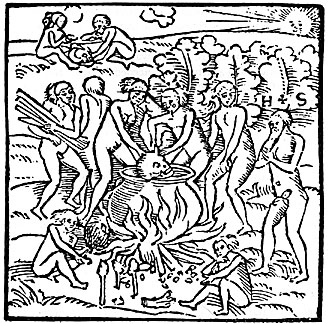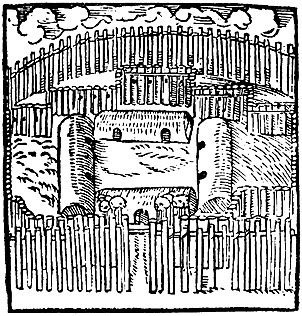free
issue
back
issues
subscribe
Athena Review, Vol. 1, No.3
Hans Staden and the Tupinamba in southeast Brazil
 Hans Staden
was a German soldier who sailed to Brazil twice on Portuguese
ships. Staden's second voyage to the New World in 1549 proved disasterous,
with all three ships being wrecked. Staden then served as a gunnery instructor
in a coastal Portuguese fort before being captured by Tupinamba warriors
in 1552, who assumed he was Portuguese.
Hans Staden
was a German soldier who sailed to Brazil twice on Portuguese
ships. Staden's second voyage to the New World in 1549 proved disasterous,
with all three ships being wrecked. Staden then served as a gunnery instructor
in a coastal Portuguese fort before being captured by Tupinamba warriors
in 1552, who assumed he was Portuguese.
Knowing the language of the
Tupi (a trading lingua franca) after three years in Brazil, Staden
was well aware of his precarious situation. His captors, having shaved off
his eyebrows with glass, clearly
intended to eat him. Staden attempted to convince
the natives that he was German, not Portuguese, and thus a friend of the
Tupinamba's French allies. A Frenchman called Karrwattware was summoned from
a Tupinamba village four miles away. After the unfortunate Staden failed
to understand his French, however, Karrwattware told the natives to "kill
him and eat eat him, the good-for-nothing, for he is indeed a Portuguese,
your enemy and mine." Things looked even bleaker for Staden when the tribal
chief, named Konyan Bebe, announced he had already helped to "kill and eat
five Portuguese who said they were Frenchmen, but had all lied."
[Fig.1: Tupinamba portrayed in cannibalistic feast observed by Staden
(orig.1557).]
 Staden somehow
managed to survive for months among the cannibalistic
Tupinamba before finally escaping. During his captivity,
he observed many aspects of this now extinct culture which he soon recorded
in a book entitled Hans Staden: The True History of his Captivity. This
two-part narrative on his confinement and Tupinamba captors was published
in 1557 after his return to Europe. It became an immediate best-seller and
was reprinted several times with translations in Dutch, Latin, and French.
The first section narrates his two voyages and the story of his capture.
Part two contains Staden's important ethnographic descriptions of the Tupinamba
villages, including subsistence and manioc preparation, pottery manufacture
and other crafts, religion, marriage customs, political practices, and
cannibalism. Staden's written and illustrated account remains a primary source
on the Tupinamba culture, which dominated large portions of southeastern
Brazil, and whose language was used for trading as far away as the Andes
at the time of initial European contact.
Staden somehow
managed to survive for months among the cannibalistic
Tupinamba before finally escaping. During his captivity,
he observed many aspects of this now extinct culture which he soon recorded
in a book entitled Hans Staden: The True History of his Captivity. This
two-part narrative on his confinement and Tupinamba captors was published
in 1557 after his return to Europe. It became an immediate best-seller and
was reprinted several times with translations in Dutch, Latin, and French.
The first section narrates his two voyages and the story of his capture.
Part two contains Staden's important ethnographic descriptions of the Tupinamba
villages, including subsistence and manioc preparation, pottery manufacture
and other crafts, religion, marriage customs, political practices, and
cannibalism. Staden's written and illustrated account remains a primary source
on the Tupinamba culture, which dominated large portions of southeastern
Brazil, and whose language was used for trading as far away as the Andes
at the time of initial European contact.
[Fig.2: Tupinamba palisaded village with skulls on gate (Staden
1557).]
.
.
Athena
Review Image Archive™ |
Guide to Archaeology on
the Internet |
free trial issue |
subscribe |
back
issues
Main
index of Athena Review |
Subject Index
| Travel
Pages |
Galleries and
Museums |
Ad
rates |
Current
issue index
Copyright ©
1996-2003
Athena Publications,
Inc. (All Rights Reserved).
 Hans Staden
was a German soldier who sailed to Brazil twice on Portuguese
ships. Staden's second voyage to the New World in 1549 proved disasterous,
with all three ships being wrecked. Staden then served as a gunnery instructor
in a coastal Portuguese fort before being captured by Tupinamba warriors
in 1552, who assumed he was Portuguese.
Hans Staden
was a German soldier who sailed to Brazil twice on Portuguese
ships. Staden's second voyage to the New World in 1549 proved disasterous,
with all three ships being wrecked. Staden then served as a gunnery instructor
in a coastal Portuguese fort before being captured by Tupinamba warriors
in 1552, who assumed he was Portuguese.
 Staden somehow
managed to survive for months among the cannibalistic
Tupinamba before finally escaping. During his captivity,
he observed many aspects of this now extinct culture which he soon recorded
in a book entitled Hans Staden: The True History of his Captivity. This
two-part narrative on his confinement and Tupinamba captors was published
in 1557 after his return to Europe. It became an immediate best-seller and
was reprinted several times with translations in Dutch, Latin, and French.
The first section narrates his two voyages and the story of his capture.
Part two contains Staden's important ethnographic descriptions of the Tupinamba
villages, including subsistence and manioc preparation, pottery manufacture
and other crafts, religion, marriage customs, political practices, and
cannibalism. Staden's written and illustrated account remains a primary source
on the Tupinamba culture, which dominated large portions of southeastern
Brazil, and whose language was used for trading as far away as the Andes
at the time of initial European contact.
Staden somehow
managed to survive for months among the cannibalistic
Tupinamba before finally escaping. During his captivity,
he observed many aspects of this now extinct culture which he soon recorded
in a book entitled Hans Staden: The True History of his Captivity. This
two-part narrative on his confinement and Tupinamba captors was published
in 1557 after his return to Europe. It became an immediate best-seller and
was reprinted several times with translations in Dutch, Latin, and French.
The first section narrates his two voyages and the story of his capture.
Part two contains Staden's important ethnographic descriptions of the Tupinamba
villages, including subsistence and manioc preparation, pottery manufacture
and other crafts, religion, marriage customs, political practices, and
cannibalism. Staden's written and illustrated account remains a primary source
on the Tupinamba culture, which dominated large portions of southeastern
Brazil, and whose language was used for trading as far away as the Andes
at the time of initial European contact.